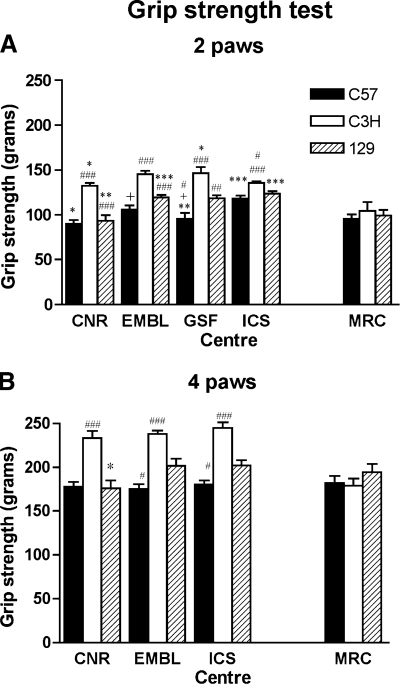Fig. 4.
Grip strength test. Forelimb (2 paws) and fore-/hindlimb (4 paws) grip force measurements of 3 mouse strains in 5 Eumorphia centers (CNR, EMBL, GSF, ICS, and MRC). Bars represent the means (±SE) grip strength measurement (in grams of force) averaged across 3 trials. A: forelimb (2-paws) grip strength. The ANOVA revealed a statistically significant effect of strain [F(2,117) = 77.60, P < 0.0001], center [F(3,117) = 14.79, P < 0.0001], and a statistically significant strain × center interaction [F(6,117) = 3.61, P = 0.0025]. Statistically significant differences between centers within each strain: *P < 0.05 CNR vs. EMBL, GSF vs. CNR; **P < 0.005 GSF vs. ICS, CNR vs. GSF; ***P < 0.0001 ICS vs. CNR, EMBL vs. CNR. Statistically significant differences between strains within each center: +P < 0.05 C57 vs. 129, #P < 0.01 C57 vs. 129, C3H vs. 129, ##P < 0.005 129 vs. C3H, ###P < 0.0001 C3H vs. C57, 129 vs. C3H, Fisher's PLSD test. B: combined fore-/hindlimb (all 4-paws) grip strength, GSF did not measure 4-paw grip strength. The ANOVA revealed a statistically significant effect of strain [F(2,91) = 64.83, P < 0.0001], center [F(2,91) = 3.36, P = 0.039], and a nonstatistically significant strain × center interaction [F(4,91) = 1.43, P = 0.229]. Statistically significant differences between centers within each strain: *P < 0.05 CNR vs. EMBL and ICS. Statistically significant differences between strains within each center: #P < 0.01 C57 vs. 129; ###P < 0.0001 C3H vs. C57 and 129, Fisher's PLSD test.

